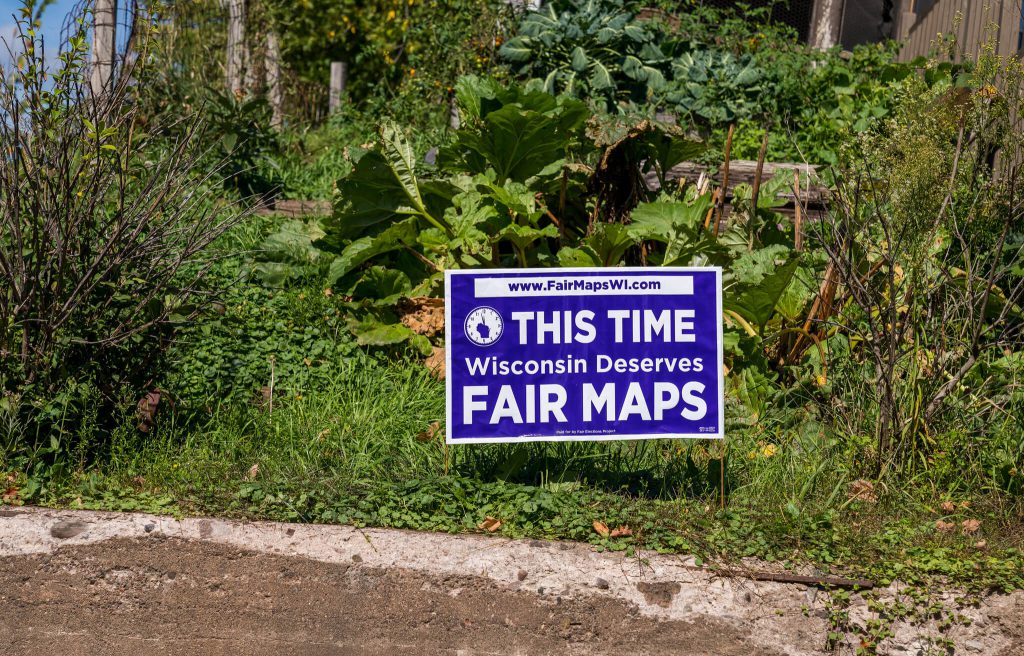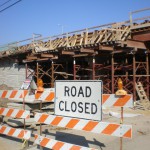Reformers Want to Change How Legislative Maps Drawn
Seeking constitutional amendment to create independent redistricting commission.

A Wisconsin Fair Maps Coalition yard sign posted in 2020. The coalition has begun a new round of work advocating for an independent, nonpartisan system of drawing Wisconsin’s legislative maps. (Photo by Tony Webster/Wisconsin Fair Maps Coalition)
With court-ordered maps that have made more Wisconsin legislative races competitive for both political parties, pro-democracy advocates are turning back to a longstanding objective: a permanent change in how the maps are drawn.
Instead of state lawmakers who are currently in charge, political reform groups are organizing to move the task to a new, independent commission that would draw Assembly and Senate districts every 10 years, following the new U.S. census, in ways that reflect Wisconsin’s close political divide.
“Our goal is to have a more accountable legislative body,” says Iuscely Flores, organizing director for the Wisconsin Fair Maps Coalition.
A change will require an amendment to the Wisconsin Constitution, which currently assigns the task of drawing legislative districts to the Wisconsin Legislature.
Until 2011, the state’s redistricting process generally went well for nearly half a century, according to Jay Heck, executive director of Common Cause Wisconsin. The Legislature was closely divided between Republicans and Democrats. Regardless of the governor’s party, the other party usually had a slim majority in either the Senate or the Assembly.
“It was split control,” says Heck. “Redistricting was usually incumbent protection, but it wasn’t particularly partisan.”
The 2010 election in Wisconsin changed that, with Republicans for the first time in a half-century getting control of the governor’s mansion and both houses of the Legislature.
In 2011 the lawmakers drew what became widely recognized as one of the most gerrymandered legislative maps in the country. “They picked the most partisan maps they could,” says Heck.
The 2012 election showed the impact: Wisconsin voters reelected Democratic President Barack Obama to a second term and sent another Democrat, Tammy Baldwin, to the U.S. Senate. And 51% of the votes for the Wisconsin Assembly were for Democratic candidates. Yet Republicans won 60 of the 99 seats in the lower house.
In the years that followed, Common Cause, the Wisconsin Democracy Campaign and the League of Women Voters all took up the cause of putting redistricting in the hands of an independent body, arguing that a group of citizens drawn from across the political spectrum could more accurately reflect the state’s true political makeup.
While the idea gained public support, it got the cold shoulder from the Legislature’s majority.
Then came the maps drawn after the 2020 census, approved in 2022 following a legal battle that was settled by the conservative majority in the Wisconsin Supreme Court. Those maps further solidified a lopsided balance between the parties in the Legislature.
In 2023, voters flipped the Court’s balance from conservative and aligned with the Republican party (although the justices are officially nonpartisan) to a majority elected with the support of the Democratic Party. For reform advocates, the switch presented a new opportunity, and the focus turned to a lawsuit challenging how the 2022 maps were drawn.
The outcome of that lawsuit in 2024 produced maps that more closely reflected the narrow partisan divide in the states. In the 2024 elections, Democrats picked up four state Senate seats, erasing a GOP supermajority, and added 14 seats in the Assembly.
While those maps were closer to fair, however, a larger problem remains, reform groups argue: the Wisconsin Constitution gives the lawmakers the ultimate power to draw their districts in ways that preserve their political advantage.
The process for amending the state constitution requires lawmakers to vote on a proposal in two successive legislative sessions, then for voters to endorse the amendment in a statewide referendum. That means a little more than four years must pass before the change could be instituted.
Flores says the coalition is keeping an eye on that timeline, with plans to engage lawmakers from both parties next year in order to get legislation introduced and passed.
“We have to fix this permanently — that is what we are now focused on,” says Penny Bernard Schaber, leader for the Fair Maps Coalition’s team in the 8th Congressional District. “We want to put both parties on notice that we need to fix what we are doing.”
Even as the maps lawsuit was underway, advocates for bigger change were continuing to meet and organize, Flores says. And after the Court ruling and the adoption of the new, fairer maps, the work for an independent redistricting body kicked into higher gear.
An ad hoc committee on redistricting reform met monthly and later more often over the last year, with participants drilling down into alternatives for structuring independent redistricting bodies.
“We were able to really study how independent redistricting commissions in other states really worked,” Flores says.
“We looked at every single state that has an independent commission,” says Debra Cronmiller, executive director of the League of Women Voters of Wisconsin. There were conversations with academics and other groups that draw legislative maps.
“We tried to glean from all of that information what would work best for Wisconsin,” Cronmiller said.
The Wisconsin Fair Maps Coalition has drawn up a draft for how a Wisconsin commission might work, but Flores emphasizes that it’s still a work in progress.
The coalition has begun a series of community hearings to engage the public, explain the concept and refine the details. Hearings were held in the Milwaukee North Shore suburbs in June and in Dodgeville on July 12.
On Wednesday evening, there will be a hearing in Green Bay at the Brown County Central Library starting at 5:30 p.m. On Thursday one is scheduled for Wausau, and more meetings are planned through the summer and into the fall.
“We’re trying to get community input,” Flores says. “There are questions we still don’t know the answers to, and we’re learning so much — it’s been an amazing, citizen-led process that I don’t think I’ve seen before.”
The groups and individuals working on the project are considering “how to make sure that the commission accurately reflects and represents the people of Wisconsin — how to make sure that we incorporate people from different political backgrounds, different ethnicities,” Flores adds. “We’re trying to be what Wisconsin looks like.”
The Court ordered fairer maps. Now reformers want to change how they’re drawn in the future was originally published by the Wisconsin Examiner.
If you think stories like this are important, become a member of Urban Milwaukee and help support real, independent journalism. Plus you get some cool added benefits.



















